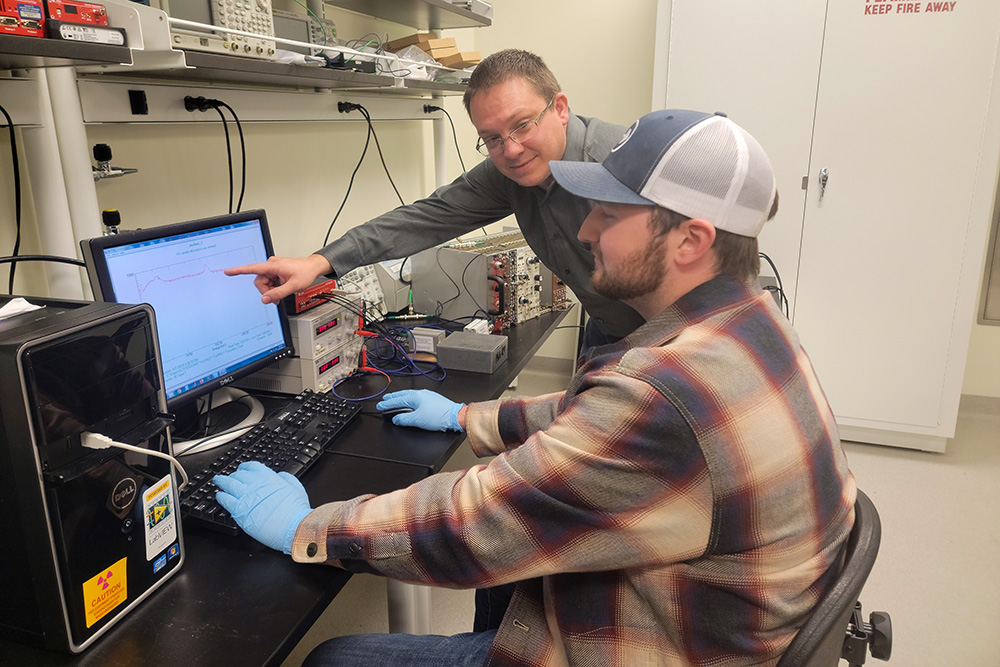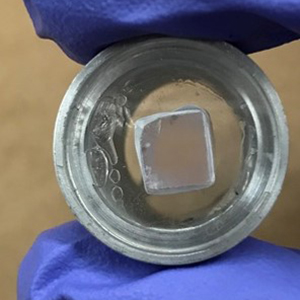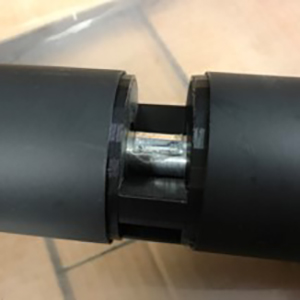
Associate Professor Eric Lukosi and NE second-year doctoral student Heath Davis
Could a banana contain the necessary ingredients to solving one of the great mysteries of science? If so, it might actually be two bananas, or specifically, two bananas worth of potassium.
Unlocking the connection between precise measurements of potassium and a potential discovery of dark matter requires world-class expertise in radiation detection. Associate Professor Eric Lukosi and his research team have utilized potassium-containing scintillators grown in UT’s Scintillation Materials Research Center to help further this quest to understand dark matter with numerous other applications for life on earth.
When astronomers started looking at the universe, it seemed that there was a lot more matter than they could observe visually. The bulk of the matter in the universe is made out of unknown dark matter, which is hypothesized to account for 85 percent of matter.
In essence, the search for dark matter is a search to understand what the universe is made out of, and scientists don’t really know what dark matter is, except something that interacts gravitationally, with theories predicting it is made up of new, exotic particles.
Experiments throughout the world have been looking for this dark matter for over three decades without much success. The DAMA experiment (DAMA stands for DArk MAtter), running since 1997, claims to have observed dark matter, though this is in tension with the results of many other experiments in the field. There is so far no widely-accepted explanation for the DAMA claim.
Potassium is a very common radioactive element and accounts for half of the human body’s radioactivity. In fact, it’s so widespread that it gets in the way of a lot of things. There are even detectors that have a potassium contamination in them. Some theorists hypothesize that understanding how the potassium in DAMA decays could constrain the interpretation of their claim.
Professor Philippe Di Stefano in the Department of Physics, Engineering Physics, and Astronomy at Queen’s University in Canada is leading the Potassium Decay (KDK) collaboration to measure a rare decay mode of potassium to help better understand the longstanding claim from the DAMA experiment.
“Studying potassium will help understand the background of their experiment, which is always a good thing,” said Di Stefano. “If this rare decay is found to be relatively frequent, it would tend to disfavor the dark matter interpretation.”
The results will also help the geochronology community improve the analytic precision of the K-Ar dating technique.
The experiment, in which several graduate students are heavily involved, utilized an enriched potassium source prepared by Oak Ridge National Laboratory (ORNL), a silicon drift detector developed by the Max-Planck Semiconductor Laboratory in Munich, and the modular total absorption spectrometer (MTAS) at ORNL, to obtain the first experimental measurements of this rare decay mode.
However, for statistical and independent verification reasons, Di Stefano sought Lukosi’s expertise using potassium-containing scintillators. Unlike the silicon drift detector, these scintillators contain the radioactive element within itself, greatly increasing the data rate and reducing the required measurement time.
The scintillator used was potassium strontium iodide, or KSr2I5(Eu2+), with a double window readout.
- A close up of the KSI (Potassium Strontium Iodide) scintillator in a sealed inert housing with windows at both ends for a double-sided readout
- A view of the whole device
- A full look of the entire device
“The two windows helped with reducing noise, because the rare decay we seek emits very low energy electrons and X-rays around 3 keV, very close to the noise floor,” said Lukosi. “Therefore, real events are identified when both readouts on the scintillator fire and is correlated to signals in MTAS. By measuring the rate between the two scintillator readouts and coincident events in MTAS, we are able to determine the probability of the rare decay mode of potassium.”
To-date, the methodology has been tested and published, and the team is now applying the methodology to potassium decay.


